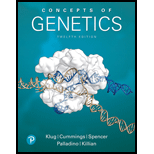
Concept explainers
A form of dwarfism known as Ellis–van Creveld syndrome was first discovered in the late 1930s, when Richard Ellis and Simon van Creveld shared a train compartment on the way to a pediatrics meeting. In the course of conversation, they discovered that they each had a patient with this syndrome. They published a description of the syndrome in 1940. Affected individuals have a short-limbed form of dwarfism and often have defects of the lips and teeth, and polydactyly (extra fingers). The largest pedigree for the condition was reported in an Old Order Amish population in eastern Pennsylvania by Victor McKusick and his colleagues (1964). In that community, about 5 per 1000 births are affected, and in the population of 8000, the observed frequency is 2 per 1000. All affected individuals have unaffected parents, and all affected cases can trace their ancestry to Samuel King and his wife, who arrived in the area in 1774. It is known that neither King nor his wife was affected with the disorder. There are no cases of the disorder in other Amish communities, such as those in Ohio or Indiana.
- (a) From the information provided, derive the most likely mode of inheritance of this disorder. Using the Hardy-Weinberg law, calculate the frequency of the mutant allele in the population and the frequency of heterozygotes, assuming Hardy— Weinberg conditions.
- (b) What is the most likely explanation for the high frequency of the disorder in the Pennsylvania Amish community and its absence in other Amish communities?
Want to see the full answer?
Check out a sample textbook solution
Chapter 26 Solutions
Concepts of Genetics (12th Edition)
- Noggin mutation: The mouse, one of the phenotypic consequences of Noggin mutationis mispatterning of the spinal cord, in the posterior region of the mouse embryo, suchthat in the hindlimb region the more ventral fates are lost, and the dorsal Pax3 domain isexpanded. (this experiment is not in the lectures).a. Hypothesis for why: What would be your hypothesis for why the ventral fatesare lost and dorsal fates expanded? Include in your answer the words notochord,BMP, SHH and either (or both of) surface ectoderm or lateral plate mesodermarrow_forwardNot part of a graded assignment, from a past midtermarrow_forwardNot part of a graded assignment, from a past midtermarrow_forward
- please helparrow_forwardWhat does the heavy dark line along collecting duct tell us about water reabsorption in this individual at this time? What does the heavy dark line along collecting duct tell us about ADH secretion in this individual at this time?arrow_forwardBiology grade 10 study guidearrow_forward
 Human Heredity: Principles and Issues (MindTap Co...BiologyISBN:9781305251052Author:Michael CummingsPublisher:Cengage Learning
Human Heredity: Principles and Issues (MindTap Co...BiologyISBN:9781305251052Author:Michael CummingsPublisher:Cengage Learning Concepts of BiologyBiologyISBN:9781938168116Author:Samantha Fowler, Rebecca Roush, James WisePublisher:OpenStax College
Concepts of BiologyBiologyISBN:9781938168116Author:Samantha Fowler, Rebecca Roush, James WisePublisher:OpenStax College Biology (MindTap Course List)BiologyISBN:9781337392938Author:Eldra Solomon, Charles Martin, Diana W. Martin, Linda R. BergPublisher:Cengage Learning
Biology (MindTap Course List)BiologyISBN:9781337392938Author:Eldra Solomon, Charles Martin, Diana W. Martin, Linda R. BergPublisher:Cengage Learning Human Biology (MindTap Course List)BiologyISBN:9781305112100Author:Cecie Starr, Beverly McMillanPublisher:Cengage Learning
Human Biology (MindTap Course List)BiologyISBN:9781305112100Author:Cecie Starr, Beverly McMillanPublisher:Cengage Learning Biology: The Dynamic Science (MindTap Course List)BiologyISBN:9781305389892Author:Peter J. Russell, Paul E. Hertz, Beverly McMillanPublisher:Cengage Learning
Biology: The Dynamic Science (MindTap Course List)BiologyISBN:9781305389892Author:Peter J. Russell, Paul E. Hertz, Beverly McMillanPublisher:Cengage Learning





